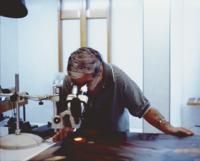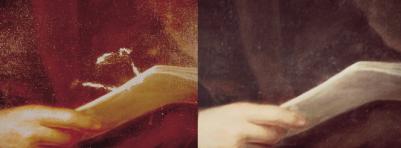Conservation of Governor's PortraitsWhen designing the Governor's Office Suite, architect Joseph M. Huston incorporated portraits of past, current, and future governors in his design for the room. Above the wood wainscot walls, Huston created decorative, architectural niches capped with a faux painted plaster to match the oak below. Each niche is unique to the portrait and requires that any governor's portrait be painted on canvas in the respective space where it will fit. The portraits were originally arranged in chronological order starting with William Penn, who rests above the ornamental fireplace in the Governor's Private Office. The portraits completely encircle the Governor's Office. The sequence is picked up in the Governor's Staff Office and currently finishes with the most recent governors' portraits in the vestibule entrance of the Governor's Reception Room. The process of conserving a portrait is very similar from one portrait to another, but unique situations have arisen. The conservation process starts with the removal of the portrait to the conservator's studio. Before any treatment occurs, a preliminary observation report is prepared, which gives a detailed account of the existing condition of the portrait and stretcher. Normally, small, inconspicuous cleaning tests are performed to gauge the necessary treatment the portrait will require. Once the condition is determined, conservation treatments are proposed for the Committee to review prior to any work occurring. Generally, all of the portraits have required some sort of conservation cleaning, including the removal of surface soil, non-original varnish, and inappropriate over-painting. Once the actual portrait was stabilized, the process of in-painting areas of the portrait that had pigment loss was restored. Finally, a coat of varnish was applied to protect the newly conserved painting. One of the unique and interesting discoveries uncovered while conserving the governors' paintings dealt with the actual portrait size. As previously noted, architect Huston incorporated portraits in the design of this office space in 1906. Obviously, by the time of construction of the new Capitol in Harrisburg, there had already been numerous governors' portraits painted. These pre-existing portraits were incorporated into the niches. To make a proper fit, some of these existing portraits were modified to fit the framed space. The oldest portraits were smaller than the uniform framing of the architecture. Canvas strips were glued to the paintings' edges and painted to match their background. In an effort to preserve the paintings and to keep the continuity of the portrait chronology, these methods were maintained and conserved when the respective portraits were reinstalled. Another discovery made by the conservators through analytical investigation were traces of gold leaf on a few of the portraits. Through deductive reasoning and past experience, it has been determined that these early portraits were once placed in individual frames and hung on walls prior to being relocated in the new 1906 Governor's Office. The total history of the governors' portraits is essentially an enigma. The names of many of the artists who painted the portraits may exist in documents, which have not yet been found. Through this project, exhaustive research has been conducted, resulting in the finding of the names of many of these artists, yet some remain unknown. To create and maintain the lineage of Pennsylvania governors, artists reproduced existing portraits for the Capitol Collection. The conservators have also uncovered several signatures and dates of artists that were, to date, unknown. Further research efforts hope to provide more insight into the artists who created this collection. |
ARTISAN EXAMINES ONE OF THE
BEFORE (LEFT) AND AFTER (RIGHT) CONSERVATION
CONSERVATOR CLEANS PORTRAIT |


